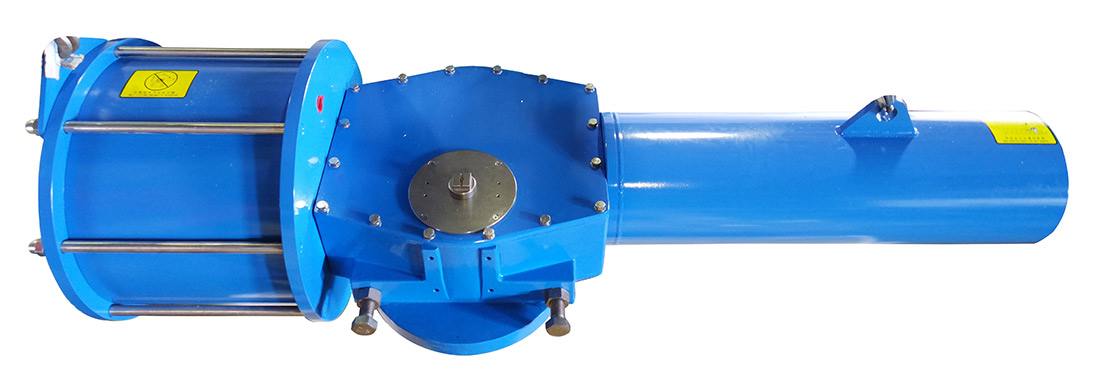News
News
Industry News
您的位置:主页 > News > Industry News >
Common Faults of Scotch Yoke Pneumatic Actuator and Its Maintenance Method
发布时间:2019-01-16 来源:艾德威尔•瑞拓
After a period of use, there will be some big and small faults in any machine. In the scotch yoke pneumatic actuator, besides the fault of indicator lamp and capacitance resistance, there are some other faults. Now let's take a look at some common phenomena in the scotch yoke pneumatic actuator and their maintenance methods.
1. Fault phenomena:
As long as the AC 220V power supply is sent to the site, the protection switch will act immediately (tripping) and the actuator will wait for the insurance to burn.
Fault diagnosis and repair process:
Firstly, the multimeter is used to detect the motor winding on the actuator. It is found that the resistance of the motor winding tends to zero, indicating that the motor has been short-circuited. Then, the resistance of both ends of the brake holder tends to infinity, indicating that the brake holder is broken, and the normal value should be about 1.45K. The final solution is to replace the new brake and motor, install the safety pipe of the servo board, re-adjust and resume normal operation.
The direction of action of the actuator is not controlled by the input signal.
Fault diagnosis and repair process:
First check the two current limiting resistors and phase-shifting capacitors are not abnormal, check the winding resistance of the motor with a multimeter, and find that the resistance of the motor is 1.45M (and changes from time to time), indicating that the winding of the motor is not correct, the final way is to replace the motor.
3. Fault phenomena:
The direction of action of the actuator is not controlled by the servo board.
Fault diagnosis and repair process:
First, let the user use the multimeter to detect two current limiting resistors and phase-shifting capacitors and winding resistance of the motor. The results of the user's inspection are consistent with the final data we provide. The three factors affecting the steering of the actuator are: (1) winding of the motor itself; (2) current limiting resistance; (3) phase shifting capacitance. There is no other possibility except these three factors.
4. Fault phenomena:
No matter what signal motor is given on site, it will not move.
Fault diagnosis and repair process:
Direct electricity between the motor windings, the motor does not transmit, the switch off or not turn, the detection of motor winding resistance values are normal, the hand wheel rolling actuator normal action. The test results are normal when the motor does not turn when the power is on. When the motor is suspected, the rotor is dismantled and the rotor is found to be unscrewed by hand. There is a solid layer of ash between the original rotor and the motor end cover. After removing this layer of ash, a little lubricant is added, and the motor can be unscrewed by hand. Re-install the motor and cooperate with the actuator. The power is normal and the motor is re-debugged.
The above four kinds are sorted out according to some information provided by customers. When the above four phenomena occur in the scotch yoke pneumatic actuator, it can be self-repaired according to the repairing process provided by the small edition. If you have other doubts, please call us.
1. Fault phenomena:
As long as the AC 220V power supply is sent to the site, the protection switch will act immediately (tripping) and the actuator will wait for the insurance to burn.
Fault diagnosis and repair process:
Firstly, the multimeter is used to detect the motor winding on the actuator. It is found that the resistance of the motor winding tends to zero, indicating that the motor has been short-circuited. Then, the resistance of both ends of the brake holder tends to infinity, indicating that the brake holder is broken, and the normal value should be about 1.45K. The final solution is to replace the new brake and motor, install the safety pipe of the servo board, re-adjust and resume normal operation.
CONCLUSION: This situation should be caused by the failure of the brake lock and the failure of the motor to be found in time on the spot, so that the motor is in the heat of blocking transmission for a long time, and the work ultimately leads to the damage of the inter-phase insulation of the motor.

The direction of action of the actuator is not controlled by the input signal.
Fault diagnosis and repair process:
First check the two current limiting resistors and phase-shifting capacitors are not abnormal, check the winding resistance of the motor with a multimeter, and find that the resistance of the motor is 1.45M (and changes from time to time), indicating that the winding of the motor is not correct, the final way is to replace the motor.
3. Fault phenomena:
The direction of action of the actuator is not controlled by the servo board.
Fault diagnosis and repair process:
First, let the user use the multimeter to detect two current limiting resistors and phase-shifting capacitors and winding resistance of the motor. The results of the user's inspection are consistent with the final data we provide. The three factors affecting the steering of the actuator are: (1) winding of the motor itself; (2) current limiting resistance; (3) phase shifting capacitance. There is no other possibility except these three factors.
4. Fault phenomena:
No matter what signal motor is given on site, it will not move.
Fault diagnosis and repair process:
Direct electricity between the motor windings, the motor does not transmit, the switch off or not turn, the detection of motor winding resistance values are normal, the hand wheel rolling actuator normal action. The test results are normal when the motor does not turn when the power is on. When the motor is suspected, the rotor is dismantled and the rotor is found to be unscrewed by hand. There is a solid layer of ash between the original rotor and the motor end cover. After removing this layer of ash, a little lubricant is added, and the motor can be unscrewed by hand. Re-install the motor and cooperate with the actuator. The power is normal and the motor is re-debugged.
The above four kinds are sorted out according to some information provided by customers. When the above four phenomena occur in the scotch yoke pneumatic actuator, it can be self-repaired according to the repairing process provided by the small edition. If you have other doubts, please call us.






